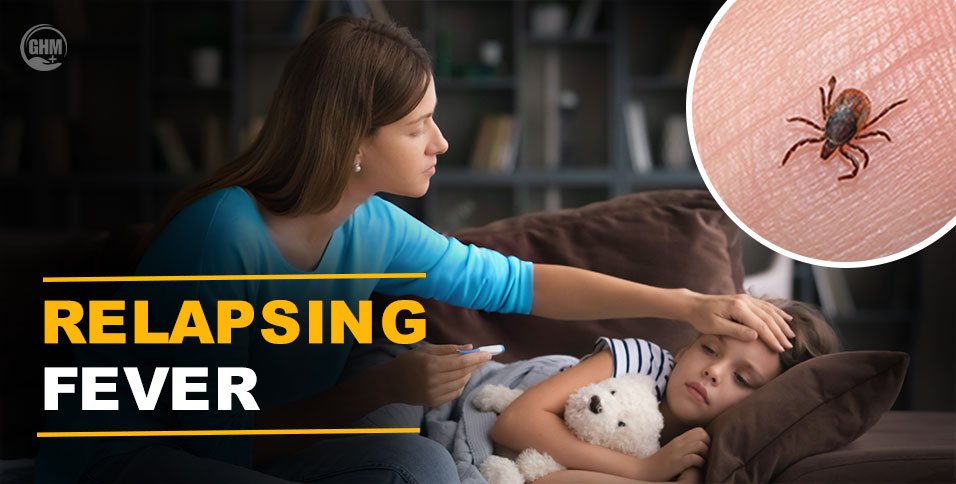If you experience fevers that return again and again, it may point to a serious infection. One possible cause is relapsing fever. This illness occurs when Borrelia bacteria enter the body through ticks or body lice.
Despite being recognised for centuries, it remains underdiagnosed in many parts of the world, especially in regions with limited healthcare access. It is named for its signature pattern of recurring fever episodes, separated by periods of wellness.
Understanding relapsing fever is critical to prevent outbreaks, supporting early diagnosis, and guiding effective treatment.
This guide provides a clear, comprehensive overview of relapsing fever, how it spreads, what symptoms to look for, who is at risk, and how to prevent it.
Let’s Understand the Relapsing Fever
1. What Is Relapsing Fever?
Relapsing fever happens when Borrelia spirochetes infect the body. These bacteria are related to the ones that cause Lyme disease, but they behave differently.
Once infected, a person goes through cycles of high fever, followed by recovery, and then another fever spike. This pattern occurs because Borrelia changes its outer proteins often. Your immune system fights one version, and then a new version appears, causing fresh symptoms.
2. Types of Relapsing Fever
1. Soft-Tick Relapsing Fever (STRF / Tick-Borne):
This is the most classically known form. Soft ticks of the Ornithodoros species spread this form.
- In the U.S., Borrelia hermsii often infects people staying in rodent-filled mountain cabins.
- B. turicatae spreads in caves and burrows.
These ticks live for decades and stay infected for life, so they remain a long-term risk. STRF occurs in Africa, Europe, Asia, and the Americas.
2. Hard-Tick Relapsing Fever (HTRF):
This form comes from Borrelia miyamotoi, spread by hard-bodied ticks like Ixodes scapularis and I. pacificus. These are the same ticks that transmit Lyme disease.
HTRF usually causes a single fever episode, and only about 10% of people have a relapse. Symptoms can start anytime from three days to six weeks after a tick bite. Cases appear in North America, Europe, Japan, and Russia.
3. Louse-Borne Relapsing Fever (LBRF):
In this form, Borrelia recurrentis spreads through the human body louse. Head lice rarely transmit it.
Historically, LBRF caused large epidemics during war, famine, and major displacement. Today, it is still common in Ethiopia, Eritrea, Somalia, and other crowded areas with limited hygiene.
The infection spreads when an infected louse gets crushed and its bacteria enter small breaks in the skin.
3. What Causes Relapsing Fever?
Relapsing fever is a zoonotic disease, meaning it passes to humans from animals through ticks or lice.
- Soft ticks transmit species like B. hermsii and B. turicatae. They bite quickly and often go unnoticed.
- Hard ticks transmit B. miyamotoi.
- Body lice spread B. recurrentis during close contact or poor hygiene.
The mechanism of relapse lies in the bacteria’s ability to change their outer surface proteins via antigenic variation. As one variant gets suppressed by the immune system, a new variant emerges, causing fresh infection and renewed symptoms.
4. Symptoms of Relapsing Fever
Symptoms often begin suddenly. They may include:
- High fever
- Chills
- Headache
- Muscle and joint pain
- Nausea or vomiting
In STRF, fever lasts around three days and returns after about a week. This cycle may repeat several times without treatment.
HTRF may cause one long fever or a short episode with fewer relapses.
LBRF also shows fewer relapses than STRF.
Complications sometimes appear. People may sweat heavily or have low blood pressure and dehydration. Rare cases of STRF can cause meningitis, eye problems, or heart inflammation.
Pregnant women face higher risks, including miscarriage or newborn infection.
A key treatment-related issue is the Jarisch–Herxheimer reaction. Symptoms suddenly worsen right after starting antibiotics because the dying bacteria release inflammatory molecules.
5. Risk Factors in Relapsing Fever
- Environmental Exposure: People staying in rodent-infested cabins, caves, or remote areas with soft tick habitats are more exposed.
- Geographic Risk: Areas where ticks or lice are endemic, such as mountainous regions and parts of Africa
- Socioeconomic Risk: Poor sanitation, overcrowding, and limited access to hygiene can lead to body lice infestations, raising LBRF risk.
- Travellers: People travelling to endemic regions may be exposed, especially where vector control is weak or sleeping conditions are risky.
- Immunocompromised People: May have more severe disease, particularly in HTRF.
6. Diagnosis
Diagnosing relapsing fever often requires a combination of clinical observation and laboratory testing.
- Microscopy: During a fever episode, spirochetes may be visible in a blood smear under microscopy, particularly with dark-field or Giemsa staining.
- Molecular testing (PCR): Serologic and molecular tests (such as PCR) are also used; however, access to these tests is limited to specialised laboratories or public health reference centres.
- Serology: Certain tests are available, but interpretation may depend on exposure history. Laboratory findings may include increased white blood cell counts, mild thrombocytopenia (low platelet count), elevated bilirubin, and prolonged clotting times.
- Clinical history: Travel, tick or louse exposure, and cyclic fever patterns help clinicians figure out the diagnosis, because Borrelia may not always be obvious outside the fever periods.
7. Treatment
The mainstay of treatment is antibiotics.
While antibiotics are sufficient for milder illnesses, severe cases could require intravenous therapy.
In pregnant women, special care is needed. Because starting antibiotic treatment often triggers a Jarisch–Herxheimer reaction (a rapid, inflammatory response).
Patients must be closely monitored, especially in the first few hours of therapy. Supportive care with fluids, rest, and treatment of complications such as hypotension or neurological issues is vital to recovery.
8. Prevention
Preventing relapsing fever requires both personal and environmental interventions.
- Avoid tick exposure:
To reduce the risk of soft-tick transmission, individuals should avoid sleeping in rodent-infested structures and ensure professionals remove rodent nests, since soft ticks can survive for years, and Ornithodoros ticks can live many years; simply sealing a building may not be enough.
- Rodent control:
Pest-control strategies include controlling rodent populations, sealing entry points, and eliminating tick habitats in and around human dwellings.
Using EPA-registered insect repellent, wearing protective clothing, avoiding tall grasses or brush, and checking for ticks after outdoor activity are recommended.
- Prevent lice infestation (for LBRF):
Preventing louse-borne relapsing fever centres on improving hygiene, frequent laundering of clothes and bedding at high temperatures, and ensuring access to showers or laundry in crowded settings.
Do not share personal items like towels or clothing, and treat lice infestations with appropriate medications.
Since there is no vaccine for relapsing fever, public health strategies remain central, especially in high-risk or displaced populations, around vector control, hygiene promotion, and surveillance.
When to See a Doctor
Seek medical attention if:
- You have repeated episodes of fever (especially if they come and go).
- You have a history of travel to high-risk regions or exposure to ticks or lice.
- During or after treatment, you develop worsening symptoms (rigours, low blood pressure), especially because of a possible Jarisch–Herxheimer reaction.
Early diagnosis and timely antibiotic therapy can prevent serious complications and reduce the risk of further relapses.
Final Thoughts
Relapsing fever remains a neglected but important disease in global health. Its ability to recur, combined with challenging diagnosis and potential for serious complications, means awareness among clinicians, public health officials, and the general public is vital.
The fact that it persists in both rural, rodent-rich environments and overcrowded, resource-poor urban settings makes it a disease of dual risk.
By prioritising prevention through vector control, hygiene, and better surveillance, we can reduce the burden of this disease, protect vulnerable populations, and avoid potentially devastating outbreaks.
Frequently Asked Questions
- Is relapsing fever the same as malaria?
No. Borrelia bacteria cause the relapsing fever, while Plasmodium parasites cause malaria. However, in regions where both are found, relapsing fever may be misdiagnosed as malaria because of overlapping fever symptoms.
- Can you spread relapsing fever to someone else?
- For louse-borne relapsing fever (LBRF): yes, indirectly — body lice can transfer Borrelia from an infected person to others.
- For tick-borne forms: transmission is via tick bite, not directly person-to-person.
- How many relapses can someone have?
It depends: in soft-tick relapsing fever, without treatment, multiple (sometimes many) relapses are possible. In louse-borne disease, there tend to be fewer relapses.
- Can relapsing fever be prevented with a vaccine?
No vaccine is currently available for relapsing fever. Prevention depends on vector control (ticks, lice), personal protection, and good hygiene.
- Is relapsing fever fatal?
- Tick-borne forms generally have low mortality if treated.
Louse-borne relapsing fever can be serious, especially in settings with limited medical care; historically, mortality was high during epidemics.


















